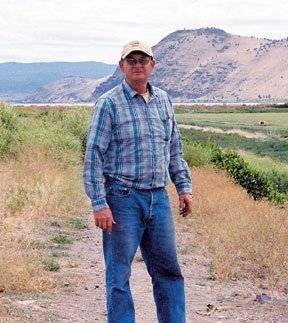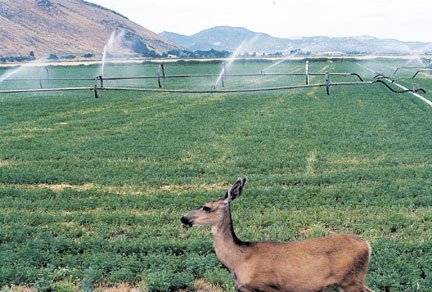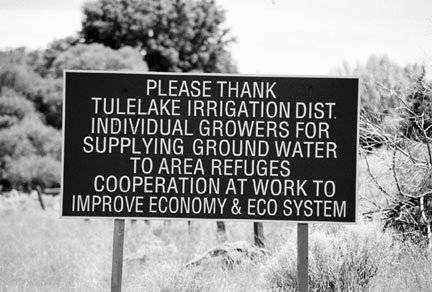
Our Klamath Basin Water Crisis
Upholding rural Americans' rights to grow food,
own property, and caretake our wildlife and natural resources.

Our Klamath Basin
Water Crisis
Upholding rural Americans' rights to grow food,
own property, and caretake our wildlife and natural resources.
|
The silent summer When farms and refuges work together the animals are the ones who benefit By Lance Waldren Pioneer Press July 25, 2007 KLAMATH BASIN - In 2001, the irrigation water was shut off and the canals, fields and ditches dried up. Guess what happened then? The wildlife with wings left and the ones without, either found water or died. This seems to be the story that has not been told in the Klamath Basin. During that summer, if you stood in one of the dry fields owned by Steve Kandra, guess what you heard---- Nothing! The wildlife was gone. Well, stand in one today and what do you hear---- The resonance of migratory species of song birds famous in the basin. Look around and watch the geese, ducks, and other birds which make this area their home. You can watch the deer grazing in the alfalfa fields, the otters and muskrats swimming in the canals and the damsel flies buzzing around your head.  Pioneer Press photo by Lance Waldren Tulelake farmer, Steve Kandra, shows the improvements made to his land for wildlife habitat. Kandra's farm borders the Tulelake Wildlife Refuge. Kandra said farming next to the refuge in the past was miserable. They were always in an adversarial role. But he said there has been a major modification in the U.S. Fish and Game philosophy since the last administration. Kandra has taken it upon himself to make changes in the way he farms. He is working in cooperation with the refuge and other groups. Instead of fighting the wildlife and trying to keep them off of his productive farm land. He now utilizes a portion of his ground to provide them with habitat, on and around his fields. "Regulation and litigation are not the answer. Cooperation and collaboration are the future. By working together we can make stuff happen. When politics become involved is when you have problems. Remember we are doing this for the critters," said Kandra. A buffer zone now surrounds each field. The approximate 30-foot perimeter is planted with perennial grasses, shrubs and other habitat for wildlife. The ground is filled with ducks' nests and the deer live the summer here, grazing the alfalfa and grains.  Pioneer Press Photo by Lance Waldren One of the many deer that use the Kandra farm to fawn and spend the summer. Kandra has made efforts to improve his farm for wildlife habitat. "I have a deer herd living on my farm. There are about 30 does that come down from the mountains in the spring and have their fawns around my fields. There is enough human activity here that it keeps the predators away and the deer do well." said Kandra Kandra also has several large pivots for irrigation. The pivots water in a circle, so Kandra has planted safflower in the corner of each field. The safflower produces an oil seed that birds devour. It is also a thickly grown, thorny plant which keeps the coyotes and other predators out. These otherwise unproductive pieces of land now are home to hundreds of pheasants, quail and other birds. The biggest project under construction on the farm is a 30-acre water treatment wetland. The wetland, which was designed by the Bureau of Reclamation, will be divided into two stages. The first stage will be used to remove phosphate rich sediment from the water and the second will be a vegetative area which will remove nitrates. Kandra said everyone has been talking about turning farm ground into wetlands to purify the water. He began asking experts about how much land would be needed to clean up a certain amount of water. No one knew the answer, so he decided to build one himself and find out. The wetlands construction has been a cooperative effort from many different agencies and groups. The water will be tested both entering and leaving the wetlands by the University of California and Oregon State University. "This has been a very expensive project, just taking 30 acres of my best ground out of production. Also the time I have spent putting this together. Now I have to get the darn thing finished," said Kandra. The U.S. Fish and Wildlife has played an active role in these changes happening in the basin. As have numerous foundations including California Waterfowl. "Every farm is a refuge and every refuge needs a farm," Kandra stated. Some might go so far as to call Kandra's project it's own refuge, even as closely tied as Basin farms and refuges are due to local farms supplying water to refuges in times of drought. "Without Agriculture, you would never see the abundance of waterfowl we have in the basin," said Dave Mauser, U.S. Fish and Wildlife Biologist. "With innovative farming, you can have your cake and eat it too. It is a win/win situation for the animals living here." It is crucial for farmers and the refuges to work together. Focusing on common ground, rather than the differences, is what makes the difference.  Pioneer Press photo by Lance Waldren This sign stands next to the road as you enter the Tulelake Wildlife Refuge. "Birds have wings and do not respect ownership boundaries. Refuges as well as agricultural land are essential for the large populations of migratory waterfowl in the basin," said Mauser. "All the large refuges in the country are interspersed with agricultural land. They have to work together." In 2001, the refuge lease lands were dry. Also the whole Lower Klamath Refuge dried completely up. What about the other wildlife not protected by the Endangered Species Act? When the water was turned off, many of them died. The mink, raccoons, weasels, frogs, snakes, turtles and skunks, the list goes on and on. These animals use the refuge as well as the agricultural land as their homes. It seems that there are several organizations in the country which want agriculture removed from the Lower Klamath Refuge and the Tulelake Refuge. "I have invited groups such as Oregon Wild, to come and see what we have done, they won't come. They do not want to see the truth, it would ruin their fundraising." said Kandra. |
Page Updated: Thursday May 07, 2009 09:15 AM Pacific
Copyright © klamathbasincrisis.org, 2007, All Rights Reserved